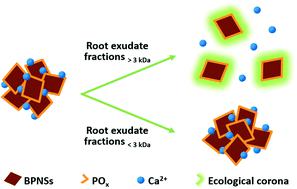当前位置:
X-MOL 学术
›
Environ. Sci.: Nano
›
论文详情
Our official English website, www.x-mol.net, welcomes your
feedback! (Note: you will need to create a separate account there.)
Species-dependent eco-corona dictates the aggregation of black phosphorus nanosheets: the role of protein and calcium
Environmental Science: Nano ( IF 5.8 ) Pub Date : 2021-09-02 , DOI: 10.1039/d1en00524c Linfeng Wei 1, 2 , Qing Zhang 1, 3 , Xingwang Hou 1, 2 , Guangbo Qu 1, 2, 4 , Jiyan Liu 1, 2, 4 , Guibin Jiang 1, 2, 4
Environmental Science: Nano ( IF 5.8 ) Pub Date : 2021-09-02 , DOI: 10.1039/d1en00524c Linfeng Wei 1, 2 , Qing Zhang 1, 3 , Xingwang Hou 1, 2 , Guangbo Qu 1, 2, 4 , Jiyan Liu 1, 2, 4 , Guibin Jiang 1, 2, 4
Affiliation

|
There are numerous application prospects for black phosphorus (BP) in biomedical and agricultural fields. Here, the dispersion stability of BP nanosheets (BPNSs) in the root zone, which is essential for its bioactivity in plants, was investigated using the root exudates of rice, pumpkin, and soybean with the presence of a common environmental ion (Ca2+). The results showed that those root exudates inhibited the aggregation of BPNSs. The critical coagulation concentrations (CCCs) of Ca2+ for BPNSs dispersed in solutions with root exudates of rice and pumpkin increased over 97 times higher than that without exudates. Soybean exudates exhibited the strongest aggregation inhibition effects, as the aggregation behavior of BPNSs was maintained in the reaction-limited regime in the tested Ca2+ concentration range (1.28 × 104–9.62 × 104 mg L−1). Exudate macromolecules were able to directly stabilize the BPNSs. The CCC values for exudate fractions >3 kDa (molecular weight >3 kDa) were over 129 times higher than that without exudates. It was proven that exudate protein was adsorbed onto the BPNSs, as promoted by Ca2+, and formed protein corona, which suppressed the attachment of BPNSs and conjunction with Ca2+ for particle growth. This study explored the inhibitory effect of ecological corona (eco-corona) on the aggregation of BPNSs in the crop root zone, and provides a crucial foundation for future studies on BP nanoparticles' interactions with organisms and potential sustainable agricultural applications. It is proposed that root exudates are an essential constituent of eco-corona, which require more attention in ultimate fate evaluation of nanoparticles.
中文翻译:

物种依赖的生态电晕决定了黑磷纳米片的聚集:蛋白质和钙的作用
黑磷(BP)在生物医学和农业领域有着众多的应用前景。在这里,BP 纳米片 (BPNSs) 在根区的分散稳定性对其在植物中的生物活性至关重要,使用大米、南瓜和大豆的根系分泌物在存在共同环境离子 (Ca 2+)。结果表明,这些根系分泌物抑制了 BPNSs 的聚集。对于分散在有水稻和南瓜根系分泌物的溶液中的 BPNSs ,Ca 2+的临界凝固浓度 ( CCCs )比没有根系分泌物的溶液高 97 倍以上。大豆分泌物表现出最强的聚集抑制作用,因为 BPNSs 的聚集行为在测试的 Ca 中保持在反应限制状态2+浓度范围(1.28 × 10 4 –9.62 × 10 4 mg L -1)。渗出物大分子能够直接稳定 BPNS。渗出液部分>3 kDa(分子量 >3 kDa)的 CCC 值比没有渗出液的高 129 倍以上。证明渗出液蛋白在Ca 2+ 的促进下吸附到BPNSs上,形成蛋白冠,抑制BPNSs的附着和与Ca 2+ 的结合用于颗粒生长。本研究探讨了生态电晕(eco-corona)对作物根区BPNSs聚集的抑制作用,为未来研究BP纳米颗粒与生物体的相互作用和潜在的可持续农业应用提供了重要基础。提出根系分泌物是生态电晕的重要组成部分,在纳米粒子的最终命运评估中需要更多关注。
更新日期:2021-09-03
中文翻译:

物种依赖的生态电晕决定了黑磷纳米片的聚集:蛋白质和钙的作用
黑磷(BP)在生物医学和农业领域有着众多的应用前景。在这里,BP 纳米片 (BPNSs) 在根区的分散稳定性对其在植物中的生物活性至关重要,使用大米、南瓜和大豆的根系分泌物在存在共同环境离子 (Ca 2+)。结果表明,这些根系分泌物抑制了 BPNSs 的聚集。对于分散在有水稻和南瓜根系分泌物的溶液中的 BPNSs ,Ca 2+的临界凝固浓度 ( CCCs )比没有根系分泌物的溶液高 97 倍以上。大豆分泌物表现出最强的聚集抑制作用,因为 BPNSs 的聚集行为在测试的 Ca 中保持在反应限制状态2+浓度范围(1.28 × 10 4 –9.62 × 10 4 mg L -1)。渗出物大分子能够直接稳定 BPNS。渗出液部分>3 kDa(分子量 >3 kDa)的 CCC 值比没有渗出液的高 129 倍以上。证明渗出液蛋白在Ca 2+ 的促进下吸附到BPNSs上,形成蛋白冠,抑制BPNSs的附着和与Ca 2+ 的结合用于颗粒生长。本研究探讨了生态电晕(eco-corona)对作物根区BPNSs聚集的抑制作用,为未来研究BP纳米颗粒与生物体的相互作用和潜在的可持续农业应用提供了重要基础。提出根系分泌物是生态电晕的重要组成部分,在纳米粒子的最终命运评估中需要更多关注。











































 京公网安备 11010802027423号
京公网安备 11010802027423号